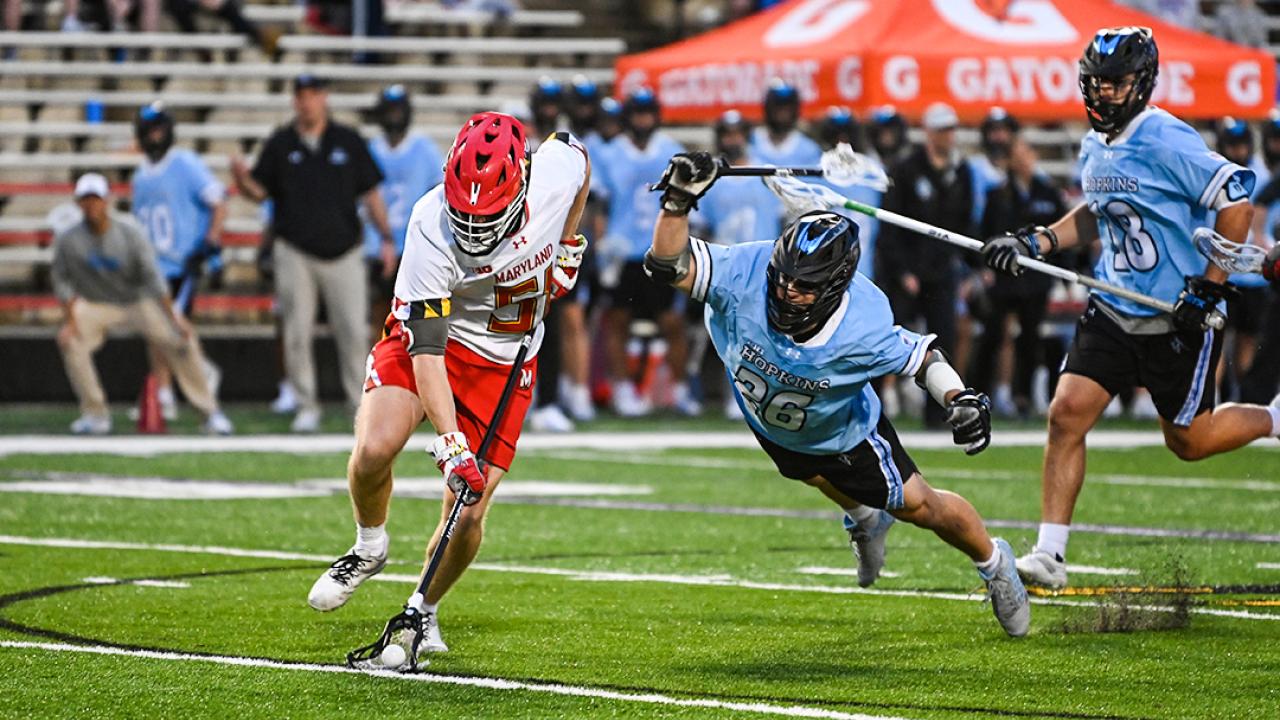
Do Your Job: Hopkins' Hawley, Michigan's Houlihan Have Niche Roles on Faceoff Wings
Emmett Houlihan’s ears perked up last month as he and his Michigan teammates participated in a midweek Zoom call with former Wolverines men’s basketball coach John Beilein.
Michigan was 5-6 and about to face Ohio State to close out the regular season, its year basically in the balance. Beilein discussed the prospect of a lesser-known player — an “outlier,” in his parlance — making a massive impact, referencing Spike Albrecht’s 17 points in the 2013 national title game.
Immediately, coach Kevin Conry looked at Houlihan.
“He was just sitting in the back of the film room at that point listening to coach, and he just lit up,” Conry said. “I was like, ‘It’s going to be Emmett Houlihan.’ He had two big goals during that game, and after the game we just hugged and I said, ‘I just knew it was going to be you.’ And he said, ‘I did, too, Coach.’”
Houlihan and Johns Hopkins’ Jack Hawley might be the most exceptional outliers hiding in plain sight in this year’s NCAA men’s lacrosse tournament. Both short stick midfielders have one task: Take a ton of faceoff wings. And both have proven influential over the course of breakout seasons for their respective programs.
There are differences between them. Hawley is a graduate student and team captain who carved out his spot over several seasons. Houlihan’s chance to play only emerged in the second half of this year.
But both have illustrated there are a lot of ways to contribute and provide value, even if the task rarely involves playing for much more than 30 seconds at a time.
“Whatever role you do have, it’s your job to accept that role and do it to the best of your ability,” Hawley said. “If that’s the main cover guy on defense or the lefty attackman who’s scoring a lot of goals, it doesn’t matter how big or small your role is. You have to embrace it and go out and attack it every day.”
Hawley’s reputation as a faceoff wing ace spans two coaching staffs. It first emerged during a scrimmage in 2020 when he was merely giving a defensive midfielder a breather. A couple weeks later, Hawley didn’t expect to see the field when the Blue Jays visited Princeton.
Instead, then-Hopkins coach Dave Pietramala — Hawley’s uncle — looked at him in the locker room and sternly said, “You’re starting on the wing.”
That season ended after only a half-dozen games because of the pandemic, and the Blue Jays didn’t have a fall to spend with a new coaching staff that arrived that offseason. But when the team convened for preseason practice, new defensive coordinator Jamison Koesterer (who also works with the faceoff unit) knew exactly who Hawley was.
“I remember him looking at me he was like, ‘You’re the guy that takes wings, right?’” Hawley recalled.
Hawley missed all of 2021 with hamstring injuries and was hurt for the first five games last season. But he firmly established himself as part of the faceoff unit, setting up the chance to thrive from the start this year.
He has 26 ground balls as the sixth-seeded Blue Jays (11-5) enter Sunday’s first-round game against Bryant. But unlike positions with obvious countable stats or even a close defenseman who has a matchup, success for Hawley is defined in ways that go well beyond numbers.
When Hawley takes a faceoff, it means Hopkins doesn’t have to use one of its short stick defensive midfielders (or offensive midfielders) on what amounts to a full sprint followed by a 3-on-3 ground ball drill.
“Those reps on those plays over time, they wear you down throughout the course of the game,” Koesterer said. “When you have someone like Jack, where his only job is to go out there after a goal is scored, it allows you to rest those other players. You’re checking off a lot of boxes at once when it comes to that.”
And that’s just the tactical element. Some of the ways Hawley can technically be effective is to not jump up field and thereby prevent a transition break or to get a ground ball or box out an opposing wing. It could be sprawling with one hand to trail check someone to stop an opportunity.
That’s the sort of thing a team draws energy from on the sideline.
“Those guys are few and far between,” Koesterer said. “When you get a guy who doesn’t get a lot of playing time and he goes out there and makes a big play, obviously the bench gets fired up. But when you have somebody who’s a fourth-year captain and he sells out the way he does and he’s out there for every single draw and our team still gets fired up when he makes a play, that says everything you need to know about Jack.”
As great as it is in the locker room, it doesn’t make it glamorous. It’s unlikely many players grow up dreaming of developing exclusively into a faceoff wing, Hawley included. (“Definitely not,” he said with a laugh).
Yet on a team that coach Peter Milliman has repeatedly said has tried to develop the best role players in the country, there might not be a better avatar than Hawley.
“I think the big thing for me, and the most rewarding thing, is I can show my teammates and coaches how committed I am to this team and just getting the job done,” Hawley said.
Houlihan spent his first season and a half just on the cusp of greater playing time. He was dominating on Michigan’s scout team earlier this season and was doing everything Conry and his staff wanted.
Then two-way midfielder Grant McCurry got hurt in mid-March, and the Wolverines needed to find a way to replace his production on offense, defense and faceoff wings. It split the work among three players, with Houlihan picking up some wing work after appearing in just two of Michigan’s first seven games.
That alone meant the gig held some appeal to the sophomore.
“Anything would get me on the field would be great, and I kind of just went with it,” Houlihan said. “I didn’t mind it. It got me excited a little bit, playing one of those roles that doesn’t really get recognized but definitely can make a big impact.”
Assistant coach Jim Rogalski told him the week of the Big Ten opener against Johns Hopkins he could possibly get a look. He took one wing before halftime, and with the score tied at the break, Houlihan pushed for more.
“I went up to coach Conry and I told him, ‘Hey coach, put me on the wings in the second half, I’m going to get you the ground ball,’” Houlihan said. “The second half starts, and from then on, I got the first two ground balls and kind of pushed transition a little bit.”
Michigan didn’t win that game, but it found a spark plug. The Wolverines won the next week at Maryland. After tight losses to Rutgers and Penn State, Houlihan scored twice against Ohio State.
Two games later, he delivered two more goals in Michigan’s 17-15 defeat of Penn State in the Big Ten semifinals.
“He’s one of the toughest sons of guns I’ve ever met in my entire life,” said Conry, whose Wolverines (9-6) visit eighth-seeded Cornell on Sunday. “He’s all about grit. He has ground-ball grit coming out of his pores. He’s one of those guys that you know if there’s something dirty and physical out there, he’s the guy you want out there.”
But he also has the skills to play offense, which is why Michigan has allowed him to stay on even after the other two members of the faceoff unit sub out. He can float behind the cage and see if there is an opportunity to dodge, or simply get the ball to one of the Wolverines’ capable attackmen and race off until the next draw.
As with Hawley, numbers don’t reveal nearly as much about how to do the job as simply a player doing the right thing over and over.
“It’s 30-second bursts, and when you only have that short amount of time, the best thing to do is one, to just get the ball — ground balls, boxing out — and then to just get the ball flowing on offense,” Houlihan said. “Make the right decisions. There’s no reason to force it. Just kind of get the defense moving a little bit and then get off the field and allow other guys to do their job. It’s pretty simple, but it can have a big impact.”
It's enough to wonder if this could be the start of a trend. Koesterer, the Hopkins assistant, said he couldn’t foresee a scenario in which a program’s sales pitch from the first day recruiting contact is permitted to involve faceoff wings as a focus.
Perhaps it’s a role that grows in prestige within specific programs, sort of like how Virginia Tech football has long revered special teams play. And most teams have at least one midfielder who is a superb athlete but can’t quite crack the lineup.
“Maybe their stick isn’t quite good enough to play offense, and maybe their skillset isn’t quite good enough to play defense, but they’re great off the ground, they have a great motor, they never get tired, they have the respect of their team,” Koesterer said. “You want that guy on the field, and you have to find a way to put that guy on the field. I think the wing is just another arena for that.”
For now, exclusive faceoff wing work is a niche for only a few players. It’s unlikely to draw much acclaim, even if teammates and coaches recognize the value of doing the task well.
Those willing to dive into it wholeheartedly could be a rare breed, something both Hopkins and Michigan have benefited from on their way to the postseason this spring.
“I do think it’s personality driven,” Conry said. “You have to have a guy like Emmett who embraces it, loves it, loves the challenge of it and has that mentality. I think it takes a very special type of kid to do it, and Emmett’s a special type of kid.”
An outlier, yet again.
Patrick Stevens
Patrick Stevens has covered college sports for 25 years. His work also appears in The Washington Post, Blue Ribbon College Basketball Yearbook and other outlets. He's provided coverage of Division I men's lacrosse to USA Lacrosse Magazine since 2010.

Related Articles





